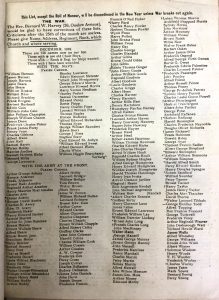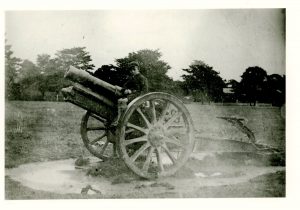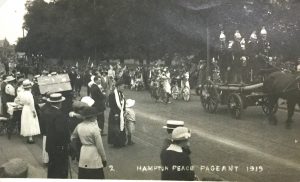Follow the Drum: a reflection [Part 2] – The Home Front Response
‘Let us remember Spring will come again…’ (May 1915, Charlotte Mew)
The Armistice Agreement had been reached, signed and implemented at 11.00 am on the 11 November 1918. Permanent security was not immediately felt on the home front. It is evident by reading the War List in the Richmond Parish Magazine for December 1918 which read ‘This list, except the Roll of Honour, will be discontinued in the New Year unless War breaks out again.’ – a statement made just one month after the signing of the agreement.

It was possible that people were in a form of shock over the whole experience and were anticipating a renewal of hostilities prior to reaching a written, signed agreement. On a personal level, vast numbers were enduring the grieving process. After nearly five long years of bitter losses it would take time to recover from the intensity of the global conflict.
There would be up to seven more months before the complete, official international settlement in Versailles was signed (Treaty of Peace between the Allied and Associated Powers and Germany. Signed at Versailles, 28 June, 1919)
Trophies of War
The image below, of a schoolboy perched on top of a captured First World War German Cannon dates from 1930s. It is a visible reminder of the sense of victory created by the end of the First World War. That particular sentiment had by then been absorbed into the ‘folk-memory’ of the local community and the connection to it remained significant and enduring. The contrast between the innocent enjoyment of the young boy and its cruel intent is stark. The boys age is unknown therefore it is not possible to say whether or not the First World War directly affected his life, though it can be presumed that the person who took the photograph, was an older family member who may have lived through the horrors of the war.

Post-war it was possible for local Urban District Councils (UDCs) to obtain such trophies of war, such as captured enemy weapons, by a process of application. Reports of battles in the papers had often referenced how hard-won they had been in terms of loss of life (for example in the Illustrated London News).
Local councils could apply to the War Office to obtain a captured German gun as a war trophy. Transportation expenses were not guaranteed. Hampton was offered a war trophy in April 1919 by the War Office, it was a field gun and in November 1919 it was decided to place it at the junction of the High Street and Church Street (the Triangle). There are several references in archived minutes for other local UDCs that attempted to obtain trophies of war.
Peace breaks out
Throughout the United Kingdom, news of peace initially spread by word of mouth, visible prompts or signs and celebratory noises such as bells, sirens and klaxons according to the BBC History Magazine. During this time period there was no national news media as it would be known today as this was an era that pre-dated even the radio. Reactions to news of the signing of the Armistice Agreement varied.
Hampton after the War
In Hampton on the night Kaiser Wilhelm II abdicated as the German Emperor and King of Prussia (9 November 1918), a dummy of the Kaiser was hung from a mock gibbet to celebrate his abdication. This type of celebration was seen throughout the country, with Hampton only being one example.
Peace celebrations were formally organised for Hampton in 1919 to commemorate the signing of the Peace Treaty. A committee was appointed with a set budget, once permission had been granted by the Local Government Board. This was reflected in the minutes for Hampton UDC, as the committee was:
‘To spend a sum not exceeding the equivalent of a penny rate for the District’. (p 260, Hampton UDC, 5 May 1919).
The committee involved Council members, Vicars, Headmasters and Headmistresses of local schools and a Minister of Religion and their brief was to maintain ‘reasonable expenses’ (p 297), in keeping with the post-war frugality. This resulted Peace Pageant (1919) can be seen with photograph:

Richmond after the War
Local council responses to the Armistice Agreement included an entry in the Richmond Council Minutes, headed ‘Signing of the Armistice by the Enemy’:
‘…the Council of the Borough of Richmond (Surrey), representing the people of the Borough, inspired by loyal devotion, beg to congratulated His Majesty the King upon the signing of the Armistice and the cessation of hostilities, and express the hope that these are the precursors of a just and lasting peace.’ (Borough of Richmond, Agendas, Minutes & Reports 9 November 1918 – 14 October 1919).
A deputation of the Watermen of Richmond met with the Mayor, Councillor Williams to arrange a Torchlight Procession for Wednesday 20 November 1918, to celebrate the signing of the Armistice. It is significant to note here that the Watermen from Richmond Parish, that fought on active service in the conflict, are documented in the Parish Magazines throughout that period. Similarly, it was also recorded in the minutes that the sons of two Councillors (Alderman Carless and Alderman Edgar) had been awarded the Military Cross for gallantry on the field.
Twickenham after the War
Twickenham UDC always referred to the First World War as the ‘European War’. An exchange of telegrams took place between that council and Buckingham Palace to mark the cessation of hostilities:
‘The District Council and inhabitants of Twickenham tender to your Majesty their dutiful and loyal respects and congratulations upon the signing of the Armistice and the probable conclusion of the war. May everlasting peace prevail and the loving bonds of union between Your Majesty and peoples ever continue.’ Chairman, Town Hall, Twickenham. (Twickenham Urban District Council, Minutes & Reports April 1918 – April 1919).
Buckingham Palace via the King’s Private Secretary replied:
‘The King thanks the District Council and inhabitants of Twickenham for their kind and loyal congratulations upon the conclusion of the Armistice with Germany.’ (Twickenham UDC, Thursday 1 November 1918).
Celebrations in Twickenham
In due course, peace celebrations were hosted in Twickenham on 19 and 26 July 1919 which included thanksgiving as well as other festivities. The programme of events was to involve and represent all of the Twickenham side of the borough and the event was described on the first page of the brochure as:

‘… the Grand Public Festivities in celebration of the Termination of the Great War (1914 1919) and Signing of Peace on 28th June, 1919’. (p1 of the Official Programme).
The United Open Air Service of Thanksgiving and Prayer was held on Twickenham Green on Sunday 20 July at 3pm. This was the formal gathering to give thanks for the termination of the war.
Entertainment in the Borough
The entertainments and activities involved the whole age-range; sports, fireworks, dancing, concerts, puppet shows, maypole dancing, roundabouts, swings, cocoa-nut shies, hoop-la, darts, dancing and refreshments. One notable group that performed was the ‘Doh Ray Me’ Concert Party, consisting of ex-soldiers and their friends. Prizes were awarded to those who partook, including bags of sweets for the schoolchildren and cash prizes for adults.
A river carnival also took place, that included a procession of illuminated boats from Radnor House to Marble Hill and a Mimic Naval Engagement took place between Glovers’ Island and Eel Pie Island. This may seem remarkable in its scale today but it probably reflects the enormity of peoples’ relief that they could return to simply enjoying life. Teddington also celebrated the peace as a town by illuminating the town hall, Elmfield House. Music for this event was provided by the Teddington Town Band and other local bands.
Life after the war
Post-war daily life was however certainly not problem free. Difficulties including rationing continued until January 1920 and sense of insecurity lingered. The Middlesex Regiment advertised for more Cadet Recruits (ages 14 – 18) in the programme for the Peace Celebrations. Veterans of the regiment participated in a 75 yard race in the Peace Celebrations for the ‘A coy Survivors’ (‘A’ company). The use of the word ‘survivors’ speaks volumes about their experience of the war and its lasting impact on the people

Workshop
This post is based on presentations given by Patricia Moloney (Local Studies Assistant) at the Local Studies Library & Archive, Richmond (6 and 13 September 2018; 23 November 2018).
Bibiography
Borough of Richmond, Agendas, Minutes & Reports 9 November 1918 – 14 October 1919.
Hampton Urban District Council, Minute Book. Volume 8.
Twickenham Urban District Council, Minutes & Reports April 1918 – April 1919.
Hampton 1915 – 1937. The story of Hampton from the First World War to the amalgamation with the Borough of Twickenham by John Sheaf. Borough of Twickenham Local History Society. Paper number 86.
Twickenham Peace Celebration, Thanksgiving and Festivities. 19 and 26 July 1919. Official Programme.
Teddington Urban District Council, Minutes. Volume 17, 1918 – 20
To read the previous posts in this series click on the following link: Follow the Drum
[Patricia Moloney, Local Studies Assistant]
Post Script
Although it is outside the scope of this article it is of interest to remember the penetrating and prophetic analysis of the great economist John Maynard Keynes who walked out of the Versailles Conference in protest. Writing in the Guardian, Robert McCrum has said, “John Maynard Keynes wrote The Economic Consequences of the Peace in the months after his resignation, developing a devastating argument to show that the treaty was not only unfair but potentially dehumanising in its effects. The reparation measures of the Versailles treaty, he demonstrates with clinical clarity, would wreck the German economy, impoverish the German people and undermine all future hopes for peace and reconciliation. Scholars will argue about the extent to which the great German inflation of the 1920s, the first step in the rise of fascism, was a by-product of the treaty’s provisions, but what Keynes brilliantly identified was the necessary interaction of sound economic policy across Europe in the maintenance of international peace among nations.” [Robert McCrum, The Guardian, 2.01.2017 (https://www.theguardian.com/books/2017/jan/02/100-best-nonfiction-books-no-48-the-economic-consequences-of-the-peace-john-maynard-keynes-jm)
A copy of the book is available to borrow from our library: The Economic Consequences of the Peace / John Maynard Keynes
